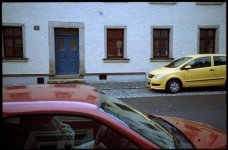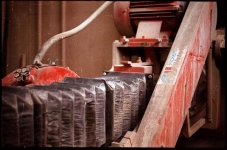petronius
Veteran
A homemade-C-41 update.
See here: http://classicameras.blogspot.com/2010/04/c-41-v.html
See here: http://classicameras.blogspot.com/2010/04/c-41-v.html
rxmd
May contain traces of nut
Interesting! Thanks.
Next time with a non-problematic camera and a non-expired film, maybe?
Next time with a non-problematic camera and a non-expired film, maybe?
petronius
Veteran
I understand the concept of a non-problematic camera, but what the ... is "non-expired film"? ;-)
petronius
Veteran
Update: Fresh chemicals this time:
http://classicameras.blogspot.com/2010/05/c-41-vi.html
http://classicameras.blogspot.com/2010/05/c-41-vi.html
petronius
Veteran
Three more examples for the use of cold developer. Developer and blix temperature were 18 deg C. The film (200ASA) was not presoaked. Developing and blix time each 25 min.
The examples are straight out of the scanner (Canoscan 8400F), only resized. Examples shot with Zorki 1/I-22 and Olympus 35RC, exposed by guess.
The examples are straight out of the scanner (Canoscan 8400F), only resized. Examples shot with Zorki 1/I-22 and Olympus 35RC, exposed by guess.
Attachments
maddoc
... likes film again.
At 20 degrees ? I have to give this a try some time ! 
petronius
Veteran
The project of abusing C-41 chemicals is in progress:
After developing approx. 25 rolls in the Colortec 1l-kit I had lost 200 ml of the developer. So I filled in water to get 1l again and developed some more rolls at 18 deg C: Developer and blix time each 30min, 30 sec initial agitation, then one inversion every 30 secs.
The pictures are straight out of the scanner with no corrections:
Nikon L35AWAF

Yashica Electro 35GS


Agfa Karat 36/Schneider Xenon 2/50mm

After developing approx. 25 rolls in the Colortec 1l-kit I had lost 200 ml of the developer. So I filled in water to get 1l again and developed some more rolls at 18 deg C: Developer and blix time each 30min, 30 sec initial agitation, then one inversion every 30 secs.
The pictures are straight out of the scanner with no corrections:
Nikon L35AWAF

Yashica Electro 35GS


Agfa Karat 36/Schneider Xenon 2/50mm

johannielscom
Snorting silver salts
Impressive stuff, I'm gonna try that.
What do you do while inversing the tank every 30 seconds for half an hour?
Question: have you ever tried cross-processing E6 in Tetenal @ 20ºC? I have two reels of Kodak SPP slide copying film I'd like to x-process, preferably at home.
What do you do while inversing the tank every 30 seconds for half an hour?
Question: have you ever tried cross-processing E6 in Tetenal @ 20ºC? I have two reels of Kodak SPP slide copying film I'd like to x-process, preferably at home.
petronius
Veteran
Surfing RFF!
Seriously I don´t invert the tank exactly every 30 secs. As I said often before, I´m a really sloppy lab worker. The next step I´m planning is stand development.
Seriously I don´t invert the tank exactly every 30 secs. As I said often before, I´m a really sloppy lab worker. The next step I´m planning is stand development.
johannielscom
Snorting silver salts
Surfing RFF!
Seriously I don´t invert the tank exactly every 30 secs. As I said often before, I´m a really sloppy lab worker. The next step I´m planning is stand development.
C-41 stand development, I'd sign up for that in a minute, being a sloppy labworker myself.
E-6 is in the farther future then, if at all? :angel:
batterytypehah!
Lord of the Dings
Hey, that makes three of us already. Let's form a sloppy lab worker club, guys! 
Thanks for your bold experiments, petronius. My affordable 35mm choices seem to be drying up, and I'll be getting back into 127 with a bulk roll of Portra 160NC soon. I need to give C-41 a try.
Thanks for your bold experiments, petronius. My affordable 35mm choices seem to be drying up, and I'll be getting back into 127 with a bulk roll of Portra 160NC soon. I need to give C-41 a try.
petronius
Veteran




C-41 at 18 deg C, stand development with ten initial inversions; developer and blix bath one hour each.
johannielscom
Snorting silver salts
The colors are getting a bit 'funny', they have an estranged feel to them (on my monitor at least, that is)
The bright colors still are okay, the less bright ones all get a certain brown murkyness to them.
For a general purpose approach this might be undesired (how much tweaking is possible on post-processing?), but if this is an effect you like then there's probably no other way to achieve it.
The light in these shots reminds me of a solar eclipse I witnessed in Holland (was it 1997?), the light then was very peculiar. Almost like dusk shortly after sunset, but yet completely different...
The bright colors still are okay, the less bright ones all get a certain brown murkyness to them.
For a general purpose approach this might be undesired (how much tweaking is possible on post-processing?), but if this is an effect you like then there's probably no other way to achieve it.
The light in these shots reminds me of a solar eclipse I witnessed in Holland (was it 1997?), the light then was very peculiar. Almost like dusk shortly after sunset, but yet completely different...
petronius
Veteran
petronius
Veteran
A little summary of use and abuse of a Tetenal Colortec C41 kit:
>>I started with a fresh mixed Tetenal C41 kit (1l).
So far I developed 33 rolls in this litre, using different methods:
>>I started with the standard 38 deg C/ rotation method.
>>When I noticed that even weak control of the temperature gave me negatives I could work with, I decided to try developing at room temperature (20 deg C).
Some searching in the web gave me a starting point at 15min with one agitation every 30 sec. When the weather got colder, the bath temperature fell to 18 deg C.
At 18 deg C I developed 30 min with identical agitation and found only minor differences in the negatives. Blix time was 30 min, same agitation.
>>Then I changed to stand development at 20 deg C. First films were developed 60 min with ten initial agitations, the negatives were a bit too dense, so the next time I reduced the developing time to 45 min. Blix time always one hour.
>>Whenever I lost parts of the developer or blix, I filled in water to get the litre again (200 ml so far).
>>I noticed an increase of red in the negatives, while blue or green tones were (more or less) normal.
>>The film was expired Centuria 200 or expired Kodak Farbwelt 200; some were exposed in metered cameras, some were exposed with sunny-16/guesstimate settings.
The pictures are uncorrected scans:


Every time I open the tank, my heartbeat is a little bit stronger;-)
>>I started with a fresh mixed Tetenal C41 kit (1l).
So far I developed 33 rolls in this litre, using different methods:
>>I started with the standard 38 deg C/ rotation method.
>>When I noticed that even weak control of the temperature gave me negatives I could work with, I decided to try developing at room temperature (20 deg C).
Some searching in the web gave me a starting point at 15min with one agitation every 30 sec. When the weather got colder, the bath temperature fell to 18 deg C.
At 18 deg C I developed 30 min with identical agitation and found only minor differences in the negatives. Blix time was 30 min, same agitation.
>>Then I changed to stand development at 20 deg C. First films were developed 60 min with ten initial agitations, the negatives were a bit too dense, so the next time I reduced the developing time to 45 min. Blix time always one hour.
>>Whenever I lost parts of the developer or blix, I filled in water to get the litre again (200 ml so far).
>>I noticed an increase of red in the negatives, while blue or green tones were (more or less) normal.
>>The film was expired Centuria 200 or expired Kodak Farbwelt 200; some were exposed in metered cameras, some were exposed with sunny-16/guesstimate settings.
The pictures are uncorrected scans:


Every time I open the tank, my heartbeat is a little bit stronger;-)
rpavich
Established
I'm going to try this!
I hate trying to keep the temp up to 102f.
I hate trying to keep the temp up to 102f.
Murray Kelly
Well-known
Would I be considered a cynic to suggest that the 38C temp was really only for 1-hour labs who expected the customer back after they had finished the shopping expedition?
Dignan's NCF-41 apparently works pretty well the same way but does need some experimentation on the part of individual users. A bit like your experiment. Thanks for the encouragement.
Dignan's NCF-41 apparently works pretty well the same way but does need some experimentation on the part of individual users. A bit like your experiment. Thanks for the encouragement.
Michel154
Established
going to try it today
joeswe
Well-known
Would I be considered a cynic to suggest that the 38C temp was really only for 1-hour labs who expected the customer back after they had finished the shopping expedition?
Of course time is money, so when the C41 process was designed by Kodak one of the design goals was that the process would be run at a temperature that would give the fastest possible processing time without being impractically short. Does this mean that saving time is the only reason why one would want to run the process at the specified temperature and we can pick a different temperature as long as we are willing to compensate for it by adjusting time? Unfortunately NO.
C41 development is more than a simple function in which temperature can be compensated by time. Why? When you develop B&W film with a developer that contains a single developing agent which is used in a given concentration and with a fixed agitation pattern, density is (within certain practical limits) mostly the product of temperature and time. That means, changes in temperature can be compensated by changing development time and the correlation is a linear one. However, developing color film is a vastly more complex process. One of the reasons is that color film consists of three dye forming layers plus other stuff in between. It takes time for the developing agent to diffuse through all these layers. The result is that the first (topmost) dye layer gets longer effective development time than the third (bottom) layer and the second layer is somewhere in between.
The three layers are engineered in a way that compensates for this, so the top layer will by design develop relatively slower and the bottom layer relatively faster, so when you take the diffusion rate of the developing agent into consideration, all three layers are developed to the same contrast and everything is fine.
Now, the problem with developing at out of spec temperatures is that the temperature not only affects the activity of the developer as such (which might or might not be affected in a non-linear way), but more importantly also affects the diffusion rate of the developer through these layers in a non-linear way. As a consequence, the carefully established balance between the developing speed of the different layers and the diffusion rate of the developing agent is thrown out of whack. You end up with different (non matching) contrast in each of the layers, which basically means "color cast".
The bottomline is unfortunately that C41 film that is developed at out of spec temperatures (anything else than the prescribed 37.8C+/-0.2C) WILL have a more or less pronounced color cast, no matter what you do. So, you might want to ask, why is everybody here and in other threads still claiming success with C41 processing at 30C, 25C or 20C?
First, nowadays most people scan their negatives or have them scanned. When following this hybrid route, even a cross color cast (and other shortcomings) can be compensated rather comfortably with the help of scanning and picture editing software. Some of it is already corrected without the user even being aware of it by the auto correcting functions the software applies. As long as we get the results that we want, there is nothing wrong with that approach, BUT it should be noted that it is NOT possible to print such a negative in the traditional way (optically in a darkroom) with normal results, because there is no way you can compensate for such a color crossover cast in a traditional darkroom workflow, at least not with reasonable means. (I once tried to print optically a set of 6x6 negatives from a film that had been developed at 30C and it was impossible to properly color balance any of the shots)
The second reason is that people have widely different quality expectations/criteria. A result that is more than good enough for one person might be unsatisfactory in the eyes of someone else who applies more critical standards. For example, when I look at the pictures in this thread, the results would be not satisfactory or acceptable to me, while for the OP they seem to be okay. Which is perfectly okay. Everybody should have his own standards or criteria and is free to judge by them. Whoever wants to process C41 at room temperature should do so and enjoy the results. But I think it would be wrong to claim that C41 film developed at room temperature will give you the same quality results (at least at the film level) that you could expect from C41 film that was developed in process run fully within spec.
mdarnton
Well-known
I have been looking for a color process that naturally gives offbeat results, and love the photos here. I'd like Petronius to come back and tell us more, now that he has five years more experience.
My current question is about capacity. Obviously he really overused the solutions. I wonder what time period that was over. My understanding of it is that C41 solutions, mixed, have a very short lifespan. Of course, that's just for people who want consistent and good results.
The other question is regarding the times for the other chemicals: usually in color processes the developer time is the most important regarding time/temperature, and the others just go to completion. I wonder if the other times could more resemble the normal times, since they aren't as temperature-critical.
Lots of questions here. . . .
My current question is about capacity. Obviously he really overused the solutions. I wonder what time period that was over. My understanding of it is that C41 solutions, mixed, have a very short lifespan. Of course, that's just for people who want consistent and good results.
The other question is regarding the times for the other chemicals: usually in color processes the developer time is the most important regarding time/temperature, and the others just go to completion. I wonder if the other times could more resemble the normal times, since they aren't as temperature-critical.
Lots of questions here. . . .
Share:
-
This site uses cookies to help personalise content, tailor your experience and to keep you logged in if you register.
By continuing to use this site, you are consenting to our use of cookies.




